Outdoor Air Pollution, Climate Change, and Human Health
Compiled by Jonathan Li of Thomas Jefferson University
What is air pollution?
In simplest terms, air pollution describes anything in the air that doesn’t normally belong. The World Health Organization (WHO) categorizes air pollution into two forms: 1) outdoor (ambient) and 2) indoor (household). Air pollution is important because it has the potential to harm both our health and our environment’s.(1)
Where does air pollution come from?
Indoor air pollution most commonly comes from open fire stoves or simple stoves that use kerosene, wood, or coal for fuel. There are also pollutants that come from second & third-hand cigarette smoke, animal dander, outdoor air pollution drifting indoors, and mold.(2)
For outdoor air pollution, the National Parks Association describes 4 major sources: mobile sources (vehicles), stationary sources (industrial facilities), area sources (farms, cities), and natural sources (wind-blown dust, trucks).(3)
The focus of this article will be on outdoor air pollution.
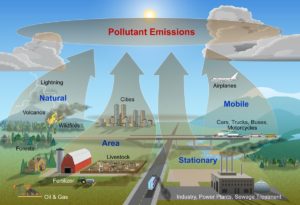
Source: https://www.nps.gov/subjects/air/sources.htm
What makes outdoor air pollution dangerous for our health?
Apart from having many sources, there are many well-studied components of air pollution that are hazardous to our health. The pollutants produced directly by the 4 major sources (mobile, stationary, area, and natural) are considered primary pollutants and includes black carbon, nitrogen dioxide, sulfur dioxide, carbon monoxide. When primary pollutants enter the atmosphere, atmospheric conditions (e.g. heat, radiation, lightning) trigger chemical reactions between these pollutants to produce secondary pollutants such as ozone, ammonium, and sulphuric acid.(4,5)
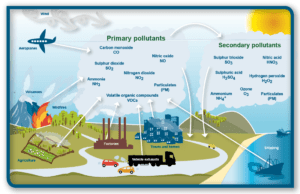
Source: https://www.mrgscience.com/ess-topic-63-photochemical-smog.html
Collectively, the components of air pollution aggregate together to form particulate matter. These are particles of air pollution small enough to be inhaled into our lungs. The smaller the particulate matter is, the more harmful it is to our health. There are two major categories for particulate matter:
- PM10 which is between 2.5-10 microns in diameter
- PM2.5 which is less than 2.5 microns in diameter
To put that into perspective, a thin human hair is approximately 50 microns in diameter. It would take 5 particles of PM10 to equal the diameter of that human hair and over 20 particles of PM2.5 to equal the diameter of that human hair. The size determines how deep this air pollution can enter our lungs.
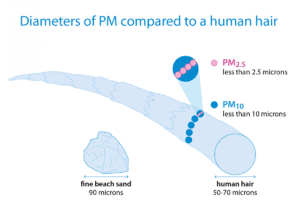
Source: https://www.blf.org.uk/sites/default/files/styles/default/public/hair.png?itok=GT0aK0Ks
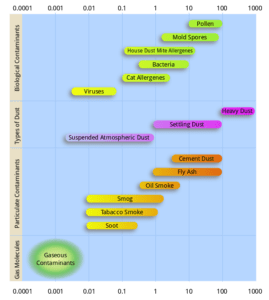
Various components of particulate matter organized by type and size (microns). Source: https://www.wikiwand.com/en/Particulates
The human lungs can be thought of as a series of tunnels in the shape of an upside down tree. It starts as a single airway in your mouth, the trachea, which can be thought of like the trunk of the tree. Then in your chest, it splits into a left and right side. These two main branches are called bronchi. The bronchi continue to split, becoming narrower and narrower, eventually becoming bronchioles, and at the very tips are tiny “buds” or air sacs called alveoli. The alveoli air sacs are very thin and allow oxygen to enter our bloodstream, and carbon dioxide to leave our body.
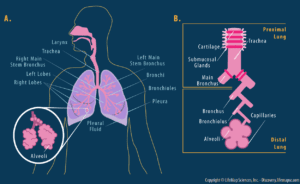
Source: http://media.discovery.lifemapsc.com/pub/uploadedFiles/images/Lung_Anatomy_and_Structure.png
PM10 is able to make it past the main bronchi and almost to the bronchioles. PM2.5 is able to reach the ends of the airways to the alveoli air sacs. The chemicals that compose PM cause irritation and inflammation of the airways, leading to decreased lung function.(6) Additionally, PM2.5 can be absorbed into the bloodstream and has the potential to harm human health beyond the lungs. Studies show that exposure to elevated PM2.5 levels above safe levels is associated with increased death, death from heart and lung disease, asthma/COPD exacerbations, stroke, hypertension, and hospitalization in the elderly with neurodegenerative diseases.(7) In children, air pollution can affect birth outcomes by increasing the risk of preterm birth, reducing fetal growth and birth weight, causing the development of asthma, and affecting intellectual and behavioral development.(8)
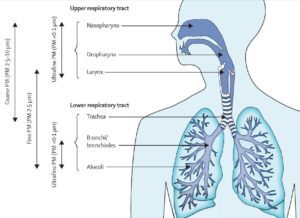
Source: https://pbs.twimg.com/media/C924mqfXgAAKG8o.jpg
How does climate change affect air pollution?
Climate change makes air pollution worse. As the environment becomes drier, the land produces more dust and increases the risk of fires. Hot temperatures also trigger more reactions between chemicals that make up air pollution, causing more smog and secondary air pollutants to be produced.
This year, in 2018, the Intergovernmental Panel on Climate Change released a major report on global warming. They report that human activities have caused an approximate increase in global temperatures by 1.0°C (1.8°F) since pre-industrial times and will reach approximately 1.5°C (2.2°F) between 2030 and 2052 if we do not make changes.(9)
Air pollution also makes climate change worse. Many common air pollutants are also greenhouse gases, which deplete the atmosphere of natural chemicals that protect the Earth from radiation. This leads to more energy from the Sun reaching the surface and increasing temperatures. Greenhouse gases also trap radiation and heat and prevent it from dissipating off Earth’s surface which also increases global temperatures.
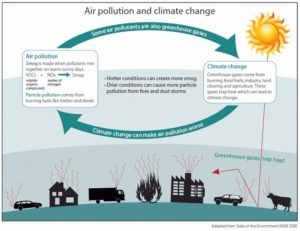
Source: https://s-media-cache-ak0.pinimg.com/736x/ec/5f/32/ec5f32ed7a5c1d117eb8fbd40dcfd7b8.jpg
How does climate change affect human health?
Apart from increasing air pollution, climate change affects health in many different ways. Hotter seasons promote pollen production which worsens allergies and asthma. Colder winters increase asthma rates and production of indoor air pollution. Climate change can alter weather patterns which lead to more devastating storms, hurricanes, floods, heat waves, and wildfires. These events force people to move from their homes, destroy communities, directly cause death, and create conditions that are hazardous to health like water contamination after flooding. Climate change also affects crop yields, food production, and clean water availability. Food and resource scarcity can also displace people from homes and create conflict what remains. Warming climates allow certain organisms that cause and spread diseases to inhabit larger geographic areas, increasing risk for human exposure. These organisms include mosquitoes, ticks, and rodents.(10)
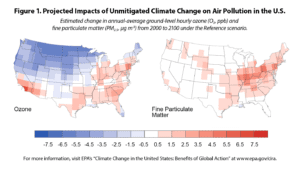
Source: https://www.epa.gov/sites/production/files/2015-06/air-quality-fig-1-download.png
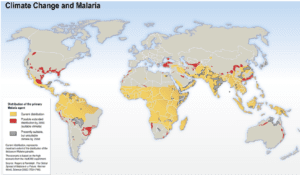
Climate change and malaria, scenario for 2050. With climate conditions changing in the future, due to increased concentrations of carbon dioxide in the atmosphere, conditions for pests also change. The primary malaria agent, the falciparum malaria parasite, will be able to spread into new areas (red from yellow), as displayed in this map, by 2050 using the Hadley CM2 high scenario. Other areas, not displayed in the map, will be uninhabitable by the parasite.
How does the government regulate air pollution?
The United States Environmental Protection Agency (US EPA) sets standards on how high specific components of air pollution can go and standardizes how states monitor air quality. Four major air pollutants (ground-level ozone, PM pollution, carbon monoxide, and sulfur dioxide) are used to calculate the Air Quality Index (AQI), an indicator of how clean the air is. When air quality is poor, it is recommended that sensitive groups (people with heart/lung disease, elderly, children, and teenagers) take precautions to reduce the time of exposure to poor quality air and to carry any respiratory medications they may have with them.(11)
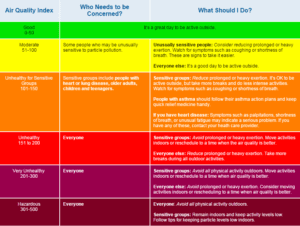
Source: https://www.theadvocate.com/new_orleans/news/weather_traffic/article_4f01939c-6aa3-11e8-b905-dfbd14fbd422.html
How is the air quality in Philadelphia and how is it monitored?
Air quality can be checked here: https://www.phila.gov/aqi/
According to the 2017 Health of the City – Philadelphia’s Community Health Assessment report, the number of good days has been increasing since 2000, and both the number of moderate and unhealthy days has been decreasing.(12)
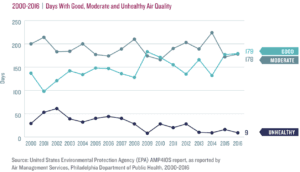
“The number of days with unhealthy air quality has declined significantly in Philadelphia, while days with good air quality have increased. In 2016, Philadelphians experienced nearly an equal number of days with good and moderate air quality.” Source: https://www.phila.gov/health/pdfs/Health_of_City_report_FINAL_lowres.pdf
Air quality in Philadelphia is monitored at 11 sites throughout the city by the Air Management Services.(14)
Asthma in Philadelphia
The Asthma and Allergy Foundation of America (AAFA) analyzes city data from 100 of the largest cities in the U.S. and rank where it is most challenging to live with asthma. In their 2018 Asthma Capitals Report, Philadelphia ranked 4th overall for Most Challenging Places
to Live With Asthma in the U.S., 11th highest for the prevalence of asthma, and 6th highest for asthma-related deaths.(13)
According to the 2017 Health of the City report, “Childhood asthma hospitalization rates are at a city-wide 15-year low of 59.5 hospitalizations per 10,000 children in 2015. Non-Hispanic black and Hispanic children had the most asthma-related hospitalizations – five to six times that of non-Hispanic white children. Hospitalization rates were highest among children in North and West Philadelphia (92.1 – 152.6 per 10,000) which is 1.5 to 2.5 times higher than the city average and 6 to 10 times higher than the lowest reported rate in the city.(12)

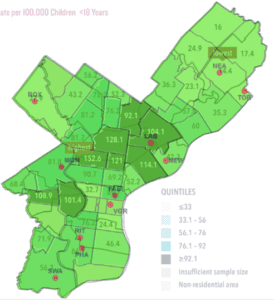
The areas of Philadelphia with the highest rates of asthma-related hospitalizations occur in communities where there is a significant lack of air monitoring.
Sources: https://www.phila.gov/health/pdfs/Health_of_City_report_FINAL_lowres.pdf & https://www.phila.gov/health/pdfs/2017%202018%20AMNP%20Fin%20Draft%20050517%20(2).pdf
Despite improving air quality as reported in the 2017 Community Health Assessment, asthma is still a major health problem in Philadelphia with some communities affected significantly more than others. In North and West Philadelphia where child asthma hospitalization rates are highest, there is a lack of air monitors in these affected communities. Thus, the air quality information that is reported may not accurately reflect the air quality in these areas of Philadelphia with high asthma rates.
How is the Clean Air Council helping?
The Clean Air Council is helping these communities by distributing air monitors to collect ground-level particulate matter air pollution data. These monitors are currently being compared to the air monitors used by the city’s Air Management Services. This information is useful in supporting community complaints of air quality violations by local construction, businesses, and industries. The monitors will also provide valuable information on the air quality of the Philadelphia neighborhoods that lack air monitoring.

Source: https://www.purpleair.com/
What you can do:
- If you want to learn how you can help your health and climate change: https://www.acponline.org/system/files/documents/advocacy/advocacy_in_action/climate_change_toolkit/climate-change.pdf
- If you have concerns about medical conditions, please consult a healthcare professional.
- If you have concerns about air quality violations in your community, contact Air Management Services and file a complaint: https://www.phila.gov/health/airmanagement/
- If you need advice on addressing air quality concerns in you may contact the Clean Air Council.
Bibliography:
- https://www.who.int/airpollution/en/
- https://www.who.int/airpollution/household/en/
- https://www.nps.gov/subjects/air/sources.htm
- https://iasmania.com/environment-pollution-air-pollutants/
- https://www.who.int/airpollution/ambient/pollutants/en/
- Szema, Anthony M. “Climate change, allergies, and asthma.” Journal of occupational and environmental medicine 53.12 (2011): 1353-1354.
- https://www.epa.gov/sites/production/files/2017-10/documents/niehs_epa_childrens_centers_impact_report_2017_0.pdf
- Thompson, Jonathan E. “Airborne Particulate Matter: Human Exposure and Health Effects.” Journal of occupational and environmental medicine 60.5 (2018): 392-423.
- http://www.ipcc.ch/report/sr15/
- https://health2016.globalchange.gov/
- https://airnow.gov/index.cfm?action=aqibasics.aqi
- https://www.phila.gov/health/pdfs/Health_of_City_report_FINAL_lowres.pdf
- http://www.aafa.org/media/2119/aafa-2018-asthma-capitals-report.pdf
14. https://www.phila.gov/health/pdfs/2017%202018%20AMNP%20Fin%20Draft%20050517%20(2).pdf


Thank you for your wonderful information, check_out one of the most reputed
Industrial Air Pollution Control Systems Manufacturers Chennai, industrial air pollution control equipment manufacturers Chennai